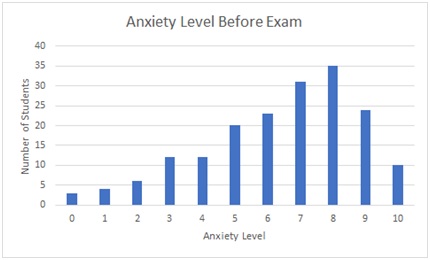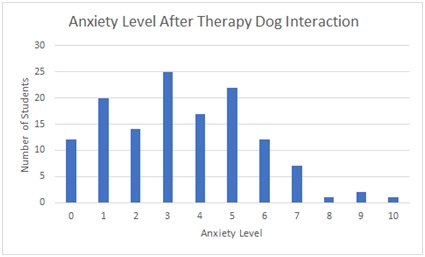
Medical Students’ Attitudes Regarding the Impact of a Therapy Dog Program on Anxiety Levels: A Pilot Study
*Corresponding Author(s):
Sara BrissonGraduate Institute Of Professional Psychology, University Of Hartford, West Hartford, Connecticut, United States
Tel:+1 5712189706,
Email:brisson@hartford.edu
Abstract
Animal-Assisted Therapy (AAT) has become common in both medical and educational settings. Evidence supports AAT as a beneficial therapeutic alternative for individuals suffering from physical disabilities and psychological disorders. In the medical schools, the use of therapy dogs has been markedly increasing on campuses due to a variety of documented mental health concerns. However, no research has examined the impact of a therapy dog program on medical student anxiety.
Methods
A six-question pre-survey was administered to students to evaluate anxiety levels. Following completion of this survey, a certified therapy dog was introduced before each exam. After 10 weeks of exposure to the therapy dog, a 12-question post-survey was administered to students.
Results
The pre-survey (n=183) demonstrated that 79% of students rated their anxiety level prior to an exam as a 5 or higher out of 10 on a Likert scale. However, after interacting with the therapy dog, the post-survey (n=150) demonstrated that only 35% of students rated their anxiety as a 5 or higher. Additionally, 93% of students that interacted with the therapy dog reported that the dog had an impact on their anxiety level and improved their learning and testing environment. Overall, 96% of students recommended the implementation of a permanent therapy dog program.
Conclusion
This study is the first to assess the impact of a therapy dog on anxiety levels of medical students. The students were near unanimous regarding a positive impact on their level of anxiety and continuation of a permanent therapy dog program.
Keywords
INTRODUCTION
Over the past several years, AAT has become more prevalent on undergraduate and graduate campuses, particularly during exam periods [10,11]. Some educational institutions that have successfully implemented permanent therapy dog programs include, Yale Law School, University of Connecticut, Fordham University, Rochester Institute of Technology, and Tufts University [12].
However, there is still a lack of AAT on medical school campuses, where anxiety, depression, and suicidal ideations are prevalent among medical students [13-16]. Research has demonstrated a relationship between chronic anxiety and depression in predisposed individuals. Specifically, sustained stress and anxiety leads to elevated Cortisol and reduced serotonin and other neurotransmitters in the brain, such as dopamine, which have been linked to depression. When the stress response fails to shut off, such as while attending medical school, it can lead to depression in susceptible individuals [17,18].
A survey study of 482 medical students found a high prevalence of anxiety and depression. Overall, 44% of students reported symptoms of anxiety and depression with 46% from first year students, 53% from second year, 47% from third year, and 29% from fourth year [17]. Another study that utilized a systematic review and meta-analysis of 195 studies, which included over 125,000 medical students from 47 different countries found that 27% of medical students screened positive for depression and that 11% reported suicidal ideation while attending medical school. Furthermore, only 16% of students who screened positive for depression reported that they sought treatment during their schooling. These findings are concerning given that the development of depression and suicidality has been linked to an increased short-term risk of suicide as well as a higher long-term risk of future depressive episodes and morbidity [15].
Few studies have been conducted to evaluate the impact of alternative therapeutic interventions on the anxiety level of medical students [19-21]. No research has examined the impact and effectiveness of a therapy dog program on the anxiety level of medical students. The purpose of this study is to evaluate the impact of a therapy dog on self-reported anxiety levels of first and second-year medical students. We hypothesized that among the students who interacted with the therapy dog, the interaction would decrease levels of self-reported anxiety before and after their exam.
METHODS
RESULTS
 Figure 1: Pre-survey self-reported medical student anxiety prior to an exam.
Figure 1: Pre-survey self-reported medical student anxiety prior to an exam.
DISCUSSION
However, there are limitations. We did not monitor participation from the pre-survey, which 183 students completed, to the post-survey, which only 150 students completed. Due to this, we are not able to appropriately conclude whether there was a significant decrease in anxiety among students potentially influenced by the therapy dog. We can only infer that there was a decrease. This allows for the expansion of this work in future studies to include a measure to evaluate student participation in the pre- and post-survey. Furthermore, while we are only inferring that the therapy dog influenced a decrease in student anxiety, it is important to consider other confounders that may have decreased anxiety, such as individual differences or maturation.
Overall, this pilot study is the first to evaluate the impact of a therapy dog program on self-reported anxiety levels of medical students prior to an exam. Results justify a more rigorous examination of the effectiveness of a therapy dog program on medical school campuses. Additionally, this study provides support for investigation into the impact of a therapy dog program on other aspect of medical student life, such as during class and clinical rotations. Our findings suggest that a therapy dog has the potential to decrease anxiety among students and accurately demonstrate that a therapy dog had a positive impact on the learning and testing environment. Continuation and expansion of the program is highly encouraged among students.
ACKNOWLEDGEMENT
REFERENCES
- Beetz A, Uvnäs-Moberg K, Julius H, Kotrschal K (2012) Psychosocial and psychophysiological effects of human-animal interactions: The possible role of oxytocin. Front Psychol 3: 234.
- Lutzky-Cohen N (2016) Motivation to use Animal-Assisted Therapy (AAT) among counselling and clinical psychology graduate students. University of Toronto 1-63.
- Rabbitt S, Kazdin A, Hong J (2014) Acceptability of animal-assisted therapy: attitudes toward aat, psychotherapy, and medication for the treatment of child disruptive behavioral problems. Anthrozoos: A Multidisciplinary Journal of the Interactions of People & Animals 27: 335-350.
- Uvnäs-Moberg K, Arn I, Magnusson D (2005) The psychobiology of emotion: the role of the oxytocinergic system. Int J Behav Med 12: 59-65.
- Allen K (2002) Cardiovascular reactivity and the presence of pets, friends, and spouses: The truth about cats and dogs. Psychosom Med 64: 727-739.
- Odendaal JS, Meintjes RA (2003) Neurophysiological correlates of affiliative behaviour between humans and dogs. Vet J 165: 296-301.
- Miller S, Kennedy C, Devoe D, Hickey M, Nelson T, et al. (2009) An examination of changes in oxytocin levels in men and women before and after interaction with a bonded dog. Anthrozoos: A Multidisciplinary Journal of the Interactions of People and Animals 22: 31-42.
- Brooks H, Rushton K, Walker S, Lovell K, Rogers A (2016) Ontological security and connectivity provided by pets: A study in the self-management of the everyday lives of people diagnosed with a long-term mental health condition. BMC Psychiatry 16: 409.
- Ross E (2016) Pets help people manage the pain of serious mental illness. Health News from NPR.
- Adamle KN, Riley TA, Carlson T (2009) Evaluating college student interest in pet therapy. J Am Coll Health 57: 545-548.
- Reynolds JA, Rabschutz L (2011) Studying for exams just got more relaxing-Animal-assisted activities at the university of Connecticut library. College & Undergraduate Libraries 18: 359-367.
- Staff Writers (2017) 10 colleges with successful pet therapy programs.
- Dyrbye LN, Thomas MR, Shanafelt TD (2006) Systematic review of depression, anxiety, and other indicators of psychological distress among US and Canadian medical students. Acad Med 81: 354-373.
- Paro HB, Morales NM, Silva CH, Rezende CH, Pinto RM, et al. (2010) Health?related quality of life of medical students. Med Educ 44: 227-235.
- Rotenstein LS, Ramos MA, Torre M, Segal JB, Peluso MJ, et al. (2016) Prevalence of depression, depressive symptoms, and suicidal ideation among medical students: a systematic review and meta-analysis. JAMA 316: 2214-2236.
- Schwenk TL, Davis L, Wimsatt LA (2010) Depression, stigma, and suicidal ideation in medical students. JAMA 304: 1181-1190.
- Jadoon NA, Yaqoob R, Raza A, Shehzad MA, Zeshan SC (2010) Anxiety and depression among medical students: a cross-sectional study. J Pak Med Assoc 60: 699-702.
- Nepon J, Belik SL, Bolton J, Sareen J (2010) The relationship between anxiety disorders and suicide attempts: Findings from the National Epidemiologic Survey on Alcohol and Related Conditions. Depress Anxiety 27: 791-798.
- Al-Dubai SAR, Al-Naggar RA, A-lShagga MA, Rampal KG (2011) Stress and coping strategies of students in a medical faculty in Malaysia. Malays J Med Sci 18: 57-64.
- Howe A, Smajdor A, Stöckl A (2012) Towards an understanding of resilience and its relevance to medical training. Med Educ 46: 349-356.
- Warnecke E, Quinn S, Ogden K, Towle N, Nelson MR (2011) A randomized controlled trial of the effects of mindfulness practice on medical student stress levels. Med Educ 45: 381-388.
APPENDIX
|
1 |
Gender |
Male Female |
||||||||||
|
2 |
Age |
< 21 21 – 25 26 – 30 31 – 40 36 – 40 > 40 |
||||||||||
|
3 |
Rate your anxiety level on a non-exam day |
0 |
1 |
2 |
3 |
4 |
5 |
6 |
7 |
8 |
9 |
10 |
|
4 |
Rate your anxiety level on an exam day |
0 |
1 |
2 |
3 |
4 |
5 |
6 |
7 |
8 |
9 |
10 |
|
5 |
Rate your anxiety level immediately following an exam |
0 |
1 |
2 |
3 |
4 |
5 |
6 |
7 |
8 |
9 |
10 |
Appendix 1: Pre-Survey Questionnaire
|
1 |
Gender |
Male Female |
||||||||||||||||||
|
2 |
Age |
< 21 21 – 25 26 – 30 31 – 40 36 – 40 > 40 |
||||||||||||||||||
|
3 |
Rate your anxiety level on a non-exam day |
0 |
1 |
2 |
3 |
4 |
5 |
6 |
7 |
8 |
9 |
10 |
||||||||
|
4 |
Rate your anxiety level on an exam day |
0 |
1 |
2 |
3 |
4 |
5 |
6 |
7 |
8 |
9 |
10 |
||||||||
|
5 |
Rate your anxiety level immediately following an exam |
0 |
1 |
2 |
3 |
4 |
5 |
6 |
7 |
8 |
9 |
10 |
||||||||
|
6 |
Did you have an interaction with Hodges, the therapy dog? |
Yes No |
||||||||||||||||||
|
7 |
How many days did you interact with the therapy dog before an exam? |
1 to 6 time(s) 7 to 12 times More than 13 times |
||||||||||||||||||
|
8 |
Please describe your interaction with the therapy dog |
Played with Pet Walked by and observed |
||||||||||||||||||
|
9 |
Rank your anxiety level after interacting with the therapy dog on an exam day |
0 |
1 |
2 |
3 |
4 |
5 |
6 |
7 |
8 |
9 |
10 |
||||||||
|
10 |
Overall, did the presence of the therapy dog have an impact on your anxiety level and improve your learning/testing environment? |
Yes No |
||||||||||||||||||
|
11 |
Would you recommend a permanent therapy dog program for medical school campuses? |
Yes No |
||||||||||||||||||
Appendix 2: Post-Survey Questionnaire
Citation: Brisson S, Purkey S, Brisson M (2017) Medical Students’ Attitudes Regarding the Impact of a Therapy Dog Program on Anxiety Levels: A Pilot Study. J Psychiatry Depress Anxiety 3: 010.
Copyright: © 2017 Sara Brisson, et al. This is an open-access article distributed under the terms of the Creative Commons Attribution License, which permits unrestricted use, distribution, and reproduction in any medium, provided the original author and source are credited.

